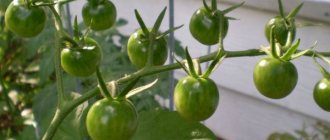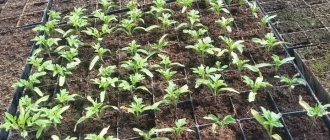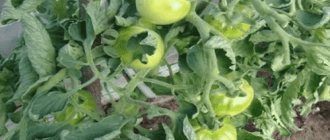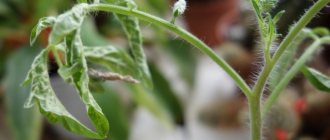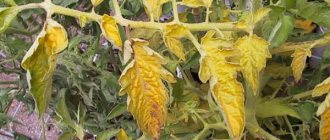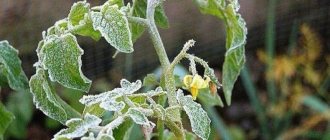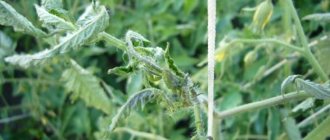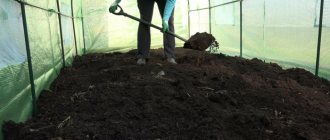Tomatoes are among the favorite crops for planting in garden plots and cottages. Compliance with temperature conditions is an important parameter of agrotechnical measures, which has a significant impact on the quality of fruits and overall yield. This indicator influences the physiological and biological processes that occur in plants from the moment they are planted in the greenhouse until the harvest of formed fruits. In order to maintain indicators at certain values, it is recommended to create a high-quality ventilation system in the greenhouse.
How to protect tomato seedlings from spring frosts
Tomato seedlings planted in an unheated greenhouse need protection from morning return frosts. The fact is that the air in the greenhouse, heated by the sun during the day, cools down as night falls.
As a rule, by morning the air temperatures in the greenhouse and outside become approximately the same. Therefore, if there is a threat of frost, all necessary measures must be taken to help protect the seedlings.
Heating
If possible, install heaters that are designed for greenhouses, smoke bombs or special thermal tablets - heaters that do not emit soot during use.
- You can also install a heater or heat fan in the greenhouse.
- You can also fill containers with hot bricks or smoldering coals and place them in several places.
- Barrels filled with hot or warm water can also help.
- Very thick wax candles, which are fixed into metal bases, will also help save plants during cold weather.
Greenhouse
But the easiest and most reliable way is to make a small greenhouse in a greenhouse; for this you can use various covering materials.
In order not to break the tomatoes, special arcs must be installed over them, onto which spunbond, film and other covering materials are placed.
Experienced gardeners advise that before frosts, be sure to water the seedlings if the soil around them is dry, and not yet open the greenhouse and moisten the covering material with a spray bottle overnight.
Greenhouse insulation
You can also insulate the greenhouse itself, but this method is used only when the tomato bushes are already very large and it is difficult to cover them with covering material. To do this, an additional cover is stretched over the greenhouse.
If at the moment there is not enough plastic film on hand, then you can use old blankets, carpets, bedspreads, etc. The main thing is to make sure that there is free space between the covering material and the greenhouse, the so-called air gap, which is good keeps warm.
Warming the beds
You can ensure that tomato seedlings in the greenhouse are not damaged by frost even before planting.
- To do this, during the preparation of planting holes, straw, peat, weeds (without roots) or a little manure are placed on their bottom.
- Then this layer is sprinkled with earth and seedlings are planted.
During the decay of such materials, a fairly large amount of heat will be released, which will warm the root system and protect it from freezing.
If you are afraid that the roots of the tomatoes may suffer from such a “thermal cushion,” then dig a ditch between the rows and fill it with any of the listed materials. Sprinkle it with soil on top and water it well.
other methods
Even if there is a threat of frost, tomatoes can be covered with bags, cardboard boxes, old buckets, rags, etc. If it happens that there is nothing at hand at the moment, but you need to act quickly, then just bury the bushes very high and their tops sprinkle with straw or grass clippings.
Preparing soil in a greenhouse
It is necessary to prepare the greenhouse and the soil in it in advance. Enrichment of the soil with nutrients by adding green manure, manure and other fertilizers has been done since autumn.
To maximize the warming of the earth, gardeners cover film greenhouses with covering material in advance (2-3 weeks in advance). In this regard, polycarbonate and glass greenhouses are much more convenient. For them, it’s enough just to close all the doors and windows in advance. In any case, it is also recommended to cover the soil itself with a black film coating that absorbs the sun's rays for faster and deeper warming. This happens in just a couple of sunny days.
How to save tomatoes from frost in a polycarbonate greenhouse
Every year, polycarbonate greenhouses are becoming more and more popular among gardeners. The fact is that such greenhouses have many advantages, but they cannot protect tomato seedlings from frost in the spring.
But you can do it, and there are several time-tested ways to do this:
- Greenhouse heating pads. Making heating pads for a greenhouse is very simple; to do this, fill plastic bottles with hot water and place them near the tomatoes, or better yet, dig them into the soil. As the water cools, it is replaced with hot water. Instead of bottles, you can use heated stones. Since this method is very labor-intensive, it is recommended to use it only in emergency cases.
- Candles. Place several wax candles (10 to 15 pieces) in the greenhouse and light them. By the way, you can use both thick and thin candles.
- Insulation of the greenhouse. If possible, insulate the polycarbonate greenhouse from the inside with film.
As a rule, its design contains elements for which the material can be hooked using clamps. Here, as in the case of conventional greenhouses, it is undesirable for the two materials to fit tightly to each other; remember that there must be an “air gap” between them.
If desired, the greenhouse can be insulated with film not from the inside, but from the outside, but in this case more material will be needed.
- Heating. Install a metal tank near the greenhouse. Porous brick is placed in it. It is then soaked in any flammable liquid. Run a pipe from the container directly to the top of the greenhouse and set fire to its contents.
Thanks to this, a warm cloud appears under the ceiling of the greenhouse, which can protect the tomato seedlings from freezing. Instead, you can install an electric heater in the greenhouse.
- Shelter. Install metal arcs over the plants and stretch insulation (lutrasil or spunbond) over them. Remember that 1 thick layer of material will protect tomatoes from the cold much worse than 2 thin ones.
- Barrel of water. Place a dark-colored barrel in the greenhouse. It is filled with water, which is heated by the sun during the day, and when night falls it gives off heat. It should be taken into account that the larger the container, the better it will “heat” the greenhouse.
At what air temperature at night can you plant seedlings in open ground.
Reviews:
Fatima Dzeitova
writes: very timely, I was wondering if I could plant it - thank you!
Fatima Dzeitova
writes: very timely, I was wondering if I could plant it - thank you!
The best “home” for them remains a greenhouse; the main thing is to choose the right one and properly equip it. The height of the greenhouse should be more than 150-180 cm, since in a low greenhouse the plants overheat more quickly. The width of the bed is 1.2 m, the distance between them should be 90-95 cm; Taking this into account, the approximate width of a small greenhouse should be 3.5 m.
How to save frozen seedlings
If you still failed to protect the tomato seedlings from spring frosts and they froze, then you need to take urgent measures to help revive them. The fact is that tomatoes are among the plants that regenerate well. And if they are properly processed and given good care, then the grown bushes will give a good harvest.
But the seedlings can only be saved if the frost was not lower than minus 3 degrees. If the bushes are covered with a crust of ice, then it is no longer possible to revive them.
Trimming
During freezing, tomatoes most often do not freeze completely. As a rule, only their upper part suffers, which becomes dark and droops.
To resuscitate damaged seedlings, you must adhere to the following action plan:
- The part of the stem that has been damaged by frost and turned dark must be removed. To do this, you need to use a sharp, pre-sterilized instrument.
- If the bushes have been very damaged by frost, they will need regular feeding with a solution of mullein or chicken droppings.
- During the first 7 days, while the plants have not yet recovered, it is recommended to build a small greenhouse over them, consisting of metal arcs and film.
Also, very often, Epin’s solution is used to save frozen tomatoes, which helps even in the most hopeless cases.
This adaptogen and biostimulant is very effective when seedlings freeze.
- Prepare the solution, strictly following the instructions on the package with the drug.
- Add a pinch of citric acid to the finished mixture.
- Late in the evening or early in the morning, spray the bushes with the resulting solution, after watering them.
- Treatment cannot be carried out during the day.
Pouring
To revive frozen seedlings, they need to be doused with cold water before the sun rises. You need to pour over each bush, trying to get the liquid on all the leaves and shoots. When the dousing procedure is completed, do not touch the bushes so as not to shake off drops of water from them.
This procedure will help restore lost moisture to plants, and it also helps stimulate sap flow.
Optimal temperature for tomato development
Various studies and experiences of agronomists and breeders have made it possible to identify recommended temperature indicators for the harmonious development of the crop. You need to take into account that they differ during the day and night hours. It is also recommended to take into account the stages of fruit growth and development, climatic conditions and weather on a given day. Main values:
- If the day is cloudy or there is not enough natural light, the temperature in the greenhouse should be 22 degrees.
- The day is sunny, no wind or rain - 28-29 degrees outside.
- Night temperature (regardless of other weather conditions) is not lower than 15 degrees.
The optimal temperature for the growth of seedlings and their planting in the greenhouse is outside the greenhouse 29 degrees
During the sprouting of tomatoes and 5-7 days after in the greenhouse, it is necessary to maintain the temperature inside the greenhouse at 13 degrees.
Tomato seedlings in 35 days Part 2
Reviews:
Vera Chadovich
writes: Valery, please tell me at what distance from the plants should the lamp be? I have 3 lamps of 10 watts each
Vera Chadovich
writes: Valery thank you very much
Vera Chadovich
writes: Valery I have 10-watt LED lamps to illuminate while the onion is on the feather, some of the feathers are flaccid and have tubercles, maybe I burned them with the lamps, please tell me, thank you.
Nikolay MOTOBLOC BISON-r-r-r
writes: I am a beginner, and I have never planted seedlings myself, but only bought ready-made ones, and the question is how to understand it on TWO ROOTS, can you be more specific? And thanks for your videos!
Tanya Tan
writes: Thank you very much for the video! Finally the second part has arrived!
